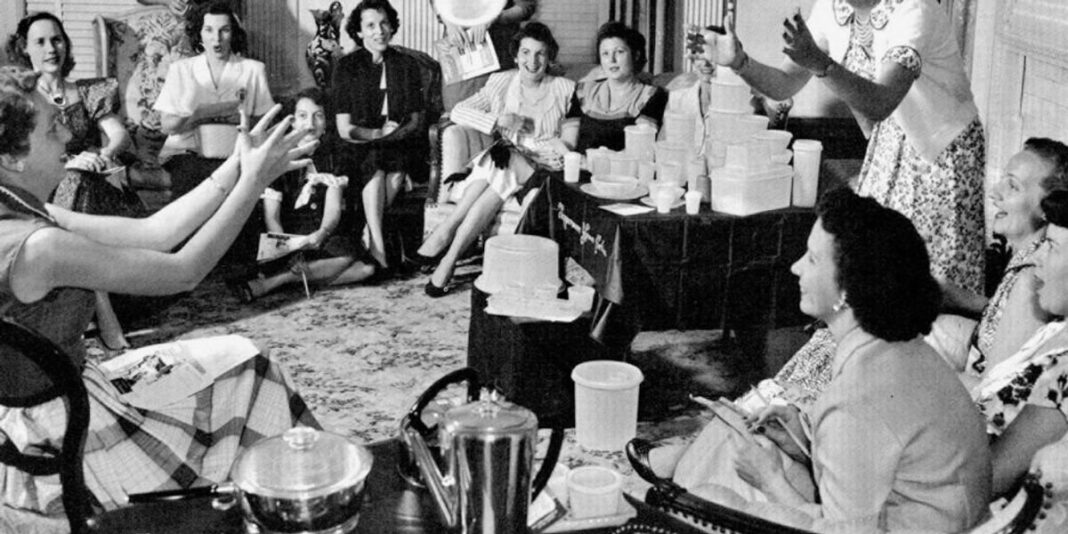Tupperware — America’s plastic kingpin, the Michael Jackson of kitchenware — is no more.
Earlier this month, the brand filed for bankruptcy.
Wise’s genius was in recognizing the untapped potential of housewives as both customers and salespeople. In living rooms across America, women were given new authority over their homes — and their finances.
Like Jackson, it was once a star, pioneering multilevel marketing and reaping profits in over 100 countries. No kitchenware made it big like Tupperware. But today, it’s more relic than revolution.
For decades, moms, grandmas, aunts, me-maws, and church ladies swore by their Tupperware, its cracked lids and warped bowls symbols of household lifetimes. In the 1950s, these inflexible bowls became a quiet catalyst for cultural change, advancing women economically and socially in ways few could have predicted.
The burping bowls that changed America
Forty years after the invention of plastic, Earl Tupper unveiled his airtight plastic containers. They must have looked like something out of science fiction. Vacuum-sealed with a “burping” lid, Tupperware reshaped the way food was stored. Suddenly, home cooks could keep ingredients fresh longer, experiment with their menus, and stock more diverse fridges.
But even a brilliant product needs more than innovation to survive.
The narrative goes that in postwar America, as men commuted to work, women felt marooned in suburbia, trapped in a loop of loneliness, grocery lists, and kitchen chores. By the late 1940s, clever minds at Tupperware decided on a radical marketing shift: They pulled the product from retail shelves and brought it straight to the consumer — one doorbell ring at a time.
Tupperware parties
By the 1950s, Tupperware wasn’t just a product; it was a movement. Brownie Wise, the savvy saleswoman who revolutionized Tupperware’s business model, pioneered the “party plan.”
The majority of Tupperware customers were, and always have been, women. So instead of sending salesmen door-to-door, Wise mobilized the most powerful force of all — women gathered in each other’s homes to buy, sell, and chat. These parties weren’t just about bowls and lids; they were social hubs, a festive remedy for suburban isolation.
Wise’s genius was in recognizing the untapped potential of housewives as both customers and salespeople. In living rooms across America, women were given new authority over their homes — and their finances.
Feminism in plastic
The same forces that fueled Tupperware’s rise — the restlessness of suburban housewives and their hunger for autonomy — would soon lead to its decline.
The postwar isolation these women faced, compounded by the numbing glow of daytime TV and a potent cocktail of tranquilizers, fostered the “problem that has no name,” at least according to the second-wave feminists who painted the entire era as hellish.
For a brief moment, though, Tupperware offered an escape hatch. These communal events were political, in the traditional sense, where Greek citizens would sit around gabbing. But for the 1950s housewife, Tupperware parties were so much more.
They transformed female friendship and offered women a glimpse of what it meant to be an entrepreneur, opening up a new space between housewife and “career woman.”
Sealing the lid shut
Ironically, the very empowerment that Tupperware fostered helped hasten its downfall. By the 1960s, as more women had entered the workforce, the cohesive Tupperware gatherings lost their magic. The ’80s brought microwave-safe containers, expired Tupperware patents, and the death of Earl Tupper.
Tupperware would never return to its mid-century heights. By the time the new millennium rolled in, the tides had fully turned.
Convenience culture demanded single-use, disposable packaging. The environmental movement painted plastic as a villain, and Tupperware found itself stranded on the wrong side of history.
The pandemic dealt the final blow to Tupperware parties. Once the brand’s lifeblood, they were now relics of a bygone era.
In June, the last Tupperware factory in the U.S. shut its doors. What once symbolized American ingenuity and entrepreneurship now seems a cautionary tale, a reminder of how easily the disruptors can become the disrupted.


